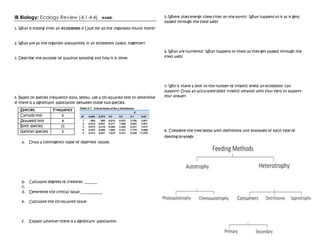
IB Biology Ecology & Climate Change Review
- 1. IB Biology: Ecology Review (4.1-4.4) NAME: 1. What is missing from an ecosystem if I just list all the organisms found there? 2. What are all the organism populations in an ecosystem called, together? 3. Describe the purpose of quadrat sampling and how it is done: 4. Based on species frequency data, below, use a chi-squared test to determine if there is a significant association between these two species: Species Frequency Cattails only 6 Seaweed only 8 Both species 11 Neither species 5 a. Draw a contingency table of observed values: b. Calculate degrees of freedom: _______ c. d. Determine the critical value:____________ e. Calculate the chi-squared value: f. Explain whether there is a significant association: 5. Where does energy come from on the earth? What happens to it as it gets passed through the food web? 6. What are nutrients? What happens to them as they get passed through the food web? 7. Why is there a limit to the number of trophic levels an ecosystem can support? Draw an accurately-sized trophic pyramid with four tiers to support your answer: 8. Complete the tree below with definitions and examples of each type of feeding strategy:
- 2. 9. Use the food web below to answer the following question: a. Identify one example of each of the following trophic levels: Producer: ____________________________________________ Primary consumer: ____________________________________________ Secondary consumer: ____________________________________________ Tertiary consumer: ____________________________________________ Decomposer: ____________________________________________ b. Using an example from the diagram above explain how organisms can be at multiple trophic levels: c. Write two food chains, below, from the food web above: 10. Use the diagram below to answer the following questions: a) State the trophic levels of organisms I and II: I: ____________________________________________ II: ___________________________________________ b) Describe what happens to the roughly 90% of energy not passed to the next level of the trophic pyramid. Include two examples of how energy is lost: c) If organism II originally contained 20,000 Calories of energy. How much energy would be obtained by organism I? d) Which organism (I or II) would there be a greater biomass (amount) of in this ecosystem and why?
- 3. 11. The topic of increasing carbon dioxide levels in the atmosphere has been the source of intense debate with regard to climate change in recent years. a. Describe the overall trend shown in the graph: b. Suggest one anthropogenic (human) impact and one natural cause that could have led to the overall trend shown in the graph: Human: Natural: c. Identify with an arrow any one point where the graph is in mid-summer. d. Explain the seasonal fluctuations in CO2 levels: 12. Explain, with the aid of a labeled diagram, the greenhouse effect. 13. Identify three greenhouse gases other than carbon dioxide: 14. Explain how increased atmospheric levels of greenhouse gases lead to an enhanced greenhouse effect. 15. Outline at least 4 possible consequences of a global temperature rise due to climate change:
- 4. i ii ii 16. Annotate the diagram of the carbon cycle, below, to indicate the ways in which carbon-based matter flows between the Earth and the atmosphere: 17. Describe the role played by each of the following in the carbon cycle: Peat formation Limestone formation Combustion Methanogenesis Carbon fixation / photosynthesis Fossilization of organic matter 18. The diagram below is part of a carbon cycle diagram for a pond ecosystem: (a) State the names of the processes (or fluxes) that: (i) convert carbon dioxide into organic compounds in pond weeds and algae (producers): (ii) convert organic compounds in pond weeds,algae and primary consumers into carbon dioxide: (b) Draw arrows on the diagram above to show how the saprotrophs obtain carbon.
